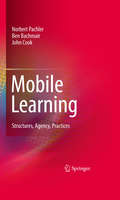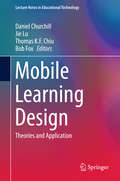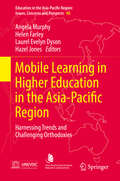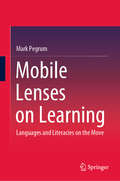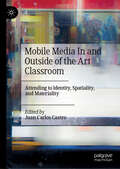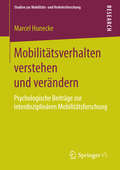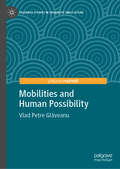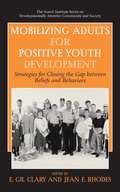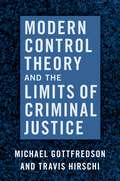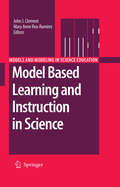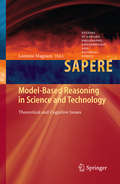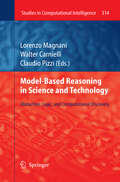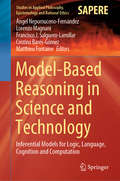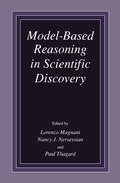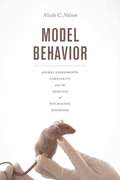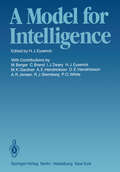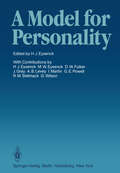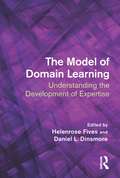- Table View
- List View
Mobile Learning: Structures, Agency, Practices
by Norbert Pachler Ben Bachmair John CookAs with television and computers before it, today’s mobile technology challenges educators to respond and ensure their work is relevant to students. What’s changed is that this portable, cross-contextual way of engaging with the world is driving a more proactive approach to learning on the part of young people. The first full-length authored treatment of the relationship between the centrality of technological development in daily life and its potential as a means of education, Mobile Learning charts the rapid emergence of new forms of mass communication and their potential for gathering, shaping, and analyzing information, studying their transformative capability and learning potential in the contexts of school and socio-cultural change. The focus is on mobile/cell phones, PDAs, and to a lesser extent gaming devices and music players, not as "the next new thing" but meaningfully integrated into education, without objectifying the devices or technology itself. And the book fully grounds readers by offering theoretical and conceptual models, an analytical framework for understanding the issues, recommendations for specialized resources, and practical examples of mobile learning in formal as well as informal educational settings, particularly with at-risk students. Among the topics covered: • Core issues in mobile learning • Mobile devices as educational resources • Socioeconomic approaches to mobile learning • Creating situations that promote mobile learning • Ubiquitous mobility and its implications for pedagogy • Bridging the digital divide at the policy level Mobile Learning is a groundbreaking volume, sure to stimulate both discussion and innovation among educational professionals interested in technology in the context of teaching and learning.
Mobile Learning Design: Theories and Application (Lecture Notes in Educational Technology #0)
by Daniel Churchill Jie Lu Thomas K.F. Chiu Bob FoxThis book focuses on mobile learning design from both theoretical and practical perspectives. It introduces and discusses how mobile learning can be effectively integrated into curricula, highlighting the design of four key components of learning-centric pedagogy: Resource, Activity, Support and Evaluation in the context of mobile learning. It also investigates the learning theories underpinning mobile learning design, and includes case studies in different contexts. It provides practical insights that allow teachers to change and transform teaching practices using mobile technology. Anyone involved in mobile-technology enhanced learning and teaching will find this book both informative and useful.
Mobile Learning in Higher Education in the Asia-Pacific Region: Harnessing Trends and Challenging Orthodoxies (Education in the Asia-Pacific Region: Issues, Concerns and Prospects #40)
by Angela Murphy Helen Farley Laurel Evelyn Dyson Hazel JonesIf mobile technologies are to be effectively used in education, how do we best implement sustainable mobile solutions for teaching and learning? The aim of this handbook is to support educators and policy makers who are investing in innovations in digital education to develop effective and sustainable mobile learning solutions for higher education environments. Authors from sixteen countries across the Asia-Pacific region have collaborated to share their experiences with developing and implementing mobile learning initiatives. These projects focus on a variety of aspects of mobile learning innovation, from the trial adoption of existing social media platforms on mobile devices and the development of specialised applications or mobile learning systems, to the large-scale, interuniversity implementation of technologies and pedagogies to support mobile learning. Each chapter addresses challenges and solutions at one or more levels of mobile learning innovation within the education system, encompassing the student perspective, the educator perspective, technical processes, policies and organisational strategy, and leadership. The book also offers a unique perspective on the integration of mobile learning innovations within the educational, political and cultural environments of Asia-Pacific countries.
Mobile Lenses on Learning: Languages and Literacies on the Move
by Mark PegrumThis book explores mobile learning as a form of learning particularly suited to our ever more mobile world, presenting a new conceptualisation of the value of mobile devices in education through the metaphor of lenses on learning. With a principal focus on mobile-assisted language learning (MALL), it draws on insights derived from MALL language, literacy and cultural projects to illustrate the possibilities inherent in all mobile learning.In its broad sweep the book takes in new and emerging technologies and tools from robots to holograms, virtual reality to augmented reality, and smart glasses to embeddable chips, considering their potential impact on education and, indeed, on human society and the planet as a whole. While not shying away from discussing the risks, it demonstrates that, handled appropriately, mobile, context-aware technologies allow educators to build on the personalised and collaborative learning facilitated by web 2.0 and social media, but simultaneously to go much further in promoting authentic learning experiences grounded in real-world encounters. In this way, teachers can better prepare students to face a global, mobile future, with all of its evolving possibilities and challenges.
Mobile Media In and Outside of the Art Classroom: Attending to Identity, Spatiality, and Materiality
by Juan Carlos CastroThis edited volume explores a range of educational effects on student learning that resulted from a long-term study using a creative visual arts curriculum designed for mobile media (smartphones and tablets) and used in art classrooms. The curriculum, entitled MonCoin, a French phrase meaning My Corner, was initially designed and piloted in a Montreal area school for at-risk youth in 2012. Since then, it has been refined, deployed, and researched across secondary schools from a range of socio-cultural educational contexts. This book is comprised of contributions from researchers and practitioners associated with the MonCoin project who address critical insights gleaned from our study, such as the social context of teen mobile media use; curriculum theory and design; influences of identity on creative practice; and specific strategies for creative applications of mobile media in schools. The purpose of this edited book is to offer art education researchers and teachers innovative curriculum for mobile media and the networked conditions that influence identity, space, and practice with and through this ubiquitous technology.
Mobilitätsbezogene Einstellungen beim Übergang vom Kindes- ins Jugendlichenalter: Querschnittliche Altersvergleiche bei 14- bis 16- Jährigen (Verkehrspsychologie)
by Thomas BastianDer Übergang vom Kindesalter in das Jugendlichenalter beinhaltet eine Vielzahl von Veränderungen und neue Freiheitsgrade in fast allen Lebensbereichen. Die Abnabelung vom Elternhaus, der Aufbau neuer sozialer Beziehungen, die Ent- ckung der eigenen Identität, die ersten weichenstellenden Entscheidungen im Bereich der Schule sind nur einige Beispiele für die Herausforderungen, denen sich die 14- bis 16-Jährigen in unserer Gesellschaft stellen müssen. Dabei geht die neue Freiheit auch einher mit einem zunehmenden Mobilitätserfordernis und einer neuen Bedeutungszuschreibung an die Mobilität (Mienert, 2002a). Mobilität ist nicht nur die schlichte Bewegung von einem Ort zu einem anderen bzw. die Überwindung des Raumes zwischen zwei Orten. Mobilität beinhaltet vielmehr auch Prestige, Emotionen und Wünsche. Oder anders aus- drückt, es geht bei der Mobilität weniger um Wege als um Aktivitäten und Wahlmöglichkeiten. Topp (1994) definiert Mobilität auch als eine Möglichkeit, den eigenen Lebensraum zu nutzen und zu erleben. Gerade die individuelle V- kehrsteilnahme erfüllt zahlreiche psychosoziale Funktionen und erfährt damit eine ernorme Bedeutungsaufladung. Neben der Regulation des Selbstwertgefühls und der Versicherung eigener Unabhängigkeit kommt der individuellen Mobi- tät auch eine wesentliche Rolle als Transmissionsmedium für Grenzerfahrungen mit Angst-Lust-Charakter sowie das Erleben heftiger Affekte und Größengefühle zu. Aufgrund des hohen subjektiven Symbolwerts wird das eigene Fahrzeug darüber hinaus auch zur Kompensation sozialer Unterlegenheit genutzt. (Auto- )mobilität gilt als Symbol für Lebensqualität schlechthin und zwar unabhängig davon, ob es diesen Anspruch auch einlöst oder nicht (Heinze und Kill, 1997).
Mobilitätsverhalten verstehen und verändern: Psychologische Beiträge zur interdisziplinären Mobilitätsforschung (Studien zur Mobilitäts- und Verkehrsforschung)
by Marcel HuneckeMarcel Hunecke erklärt die Mobilität von Menschen aus psychologischer Perspektive. Hierzu werden die innerpsychischen Einflussfaktoren des Mobilitätsverhaltens benannt und in ihrer Interaktion mit situationsbezogenen Merkmalen dargestellt. Eine wesentliche Voraussetzung zur erfolgreichen Veränderung von Mobilitätsverhalten besteht in der Segmentierung von NutzerInnengruppen. Die hierfür entwickelten Ansätze werden vorgestellt und jeweils hinsichtlich ihrer spezifische Vor-und Nachteile bewertet. Weiterhin werden personenfokussierte Interventionen zur Förderung nachhaltiger Mobilitätsmuster systematisiert und in ihren psychologischen Wirkmechanismen beschrieben.
Mobilities and Human Possibility (Palgrave Studies in Creativity and Culture)
by Vlad Petre GlăveanuThis book brings together mobilities and possibility studies by arguing that the possible emerges in our experience in and through acts of movement : physical, social and symbolic. The basic premise that mobility begets possibility is supported with evidence covering a wide range of geographic and temporal scales. First, in relation to the evolution of our species and the considerable impact of mobility on the emergence and spread of prehistoric innovations; second, considering the circulation of people, things and creative ideas throughout history; third, in view of migrations that define an individual life course and its numerous (im)possibilities; and fourth, in the ‘inner’, psychological movements specific for our wandering – and wondering – minds.This is not, however, a romantic account of how more mobility is always better or leads to increased creativity and innovation. After all, movement can fail in opening up new possibilities, and innovations can cause harm or reduce our agency. And yet, at an ontological level, the fact remains that it is only by moving from one position to another that we develop novel perspectives on the world and find alternative ways of acting and being. At this foundational level, mobilities engender possibilities and the latter, in turn, fuel new mobilities. This interplay, examined throughout the book, should be of interest for researchers and practitioners working on mobility, migration, creativity, innovation, cultural diffusion, life course approaches and, more generally, on the possibilities embedded in mobile lives.
Mobilizing Adults for Positive Youth Development: Strategies for Closing the Gap between Beliefs and Behaviors (The Search Institute Series on Developmentally Attentive Community and Society #4)
by E. Gil Clary Jean E. RhodesIn today’s fast-paced, often-dehumanizing world, this book brings together the advice and expertise of leading scholars dedicated to affecting positive youth development. Providing a multifaceted, multidisciplinary blueprint for social change the book promotes individual adult involvement in adolescents’ lives to ensure positive youth development. It aims to mobilize a society of adults, through volunteer and other programs, and will interest anyone involved in working toward achieving positive youth development.
MOD CONTR THEORY & LIMITS OF CRIM JUST C
by Travis Hirschi Michael GottfredsonIn 1990 when Michael Gottfredson and Travis Hirschi published A General Theory of Crime, now often referred to as self control theory, it quickly became among the most discussed and researched perspectives in criminology. In Modern Control Theory and the Limits of Criminal Justice, Gottfredson and Hirschi develop and extend the theory of self control advanced in their classic work. Focusing on the methodology of testing crime theory and measuring behavioral research on crime and delinquency, they critically review the evidence about self control theory. Gottfredson and Hirschi further discuss evidence about the positive consequences of higher levels of self control from education, economics, and public health, that-along with evidence from delinquency and crime-show substantial support for the theory of self control. Illustrating the theory through predictions about policing, incarceration, juvenile justice, and the connection of immigration policy to crime, this book connects self control theory to the structure and function of the criminal justice system, then applies the theory to pressing issues of public policy about delinquency and crime.
MOD & MED OF YOUTH TREATMENT OUTCOMES C
The study of moderation and mediation of youth treatment outcomes has been recognized as enormously beneficial in recent years. However, these benefits have never been fully documented or understood by researchers, clinicians, and students in training. After nearly 50 years of youth treatment outcome research, identifying moderators and mediators is the natural next step-shifting focus to mechanisms responsible for improved outcomes, identifying youth who will benefit from certain treatments or who are in need of alternative treatments, and recognizing the challenges associated with the study of moderators and mediators and their routine use in clinical practice. Moderators and Mediators of Youth Treatment Outcomes examines conceptual and methodological challenges related to the study of moderation and mediation and illustrates potential treatment moderators and mediators for specific disorders. The volume also considers empirical evidence for treatment moderators and mediators of specific disorders and illustrates how theoretical and empirical knowledge regarding moderators and mediators can be harnessed and disseminated to clinical practice. This book will be invaluable to researchers conducting treatment outcome studies (both efficacy and effectiveness), clinicians interested in evidence-based work and in understanding for whom and why certain treatments work, and students of clinical child and adolescent psychology and psychiatry.
Model Based Learning and Instruction in Science (Models and Modeling in Science Education #2)
by John Clement Mary Anne Rea-RamirezAnyone involved in science education will find that this text can enhance their pedagogical practice. It describes new, model-based teaching methods that integrate social and cognitive perspectives for science instruction. It presents research that describes how these new methods are applied in a diverse group of settings, including middle school biology, high school physics, and college chemistry classrooms. They offer practical tips for teaching the toughest of key concepts.
Model-Based Reasoning in Science and Technology: Theoretical and Cognitive Issues (Studies in Applied Philosophy, Epistemology and Rational Ethics #8)
by Lorenzo MagnaniThis book contains contributions presented during the international conference on Model-Based Reasoning (MBR´012), held on June 21-23 in Sestri Levante, Italy. Interdisciplinary researchers discuss in this volume how scientific cognition and other kinds of cognition make use of models, abduction, and explanatory reasoning in order to produce important or creative changes in theories and concepts. Some of the contributions analyzed the problem of model-based reasoning in technology and stressed the issues of scientific and technological innovation. The book is divided in three main parts: models, mental models, representations; abduction, problem solving and practical reasoning; historical, epistemological and technological issues. The volume is based on the papers that were presented at the international
Model-Based Reasoning in Science and Technology: Abduction, Logic, and Computational Discovery (Studies in Computational Intelligence #314)
by Lorenzo Magnani Walter Carnielli Claudio PizziModel-Based Reasoning in Science and Technology: Inferential Models for Logic, Language, Cognition and Computation (Studies in Applied Philosophy, Epistemology and Rational Ethics #49)
by Ángel Nepomuceno-Fernández Lorenzo Magnani Francisco J. Salguero-Lamillar Cristina Barés-Gómez Matthieu FontaineThis book discusses how scientific and other types of cognition make use of models, abduction, and explanatory reasoning in order to produce important and innovative changes in theories and concepts. Gathering revised contributions presented at the international conference on Model-Based Reasoning (MBR18), held on October 24–26 2018 in Seville, Spain, the book is divided into three main parts. The first focuses on models, reasoning, and representation. It highlights key theoretical concepts from an applied perspective, and addresses issues concerning information visualization, experimental methods, and design. The second part goes a step further, examining abduction, problem solving, and reasoning. The respective papers assess different types of reasoning, and discuss various concepts of inference and creativity and their relationship with experimental data. In turn, the third part reports on a number of epistemological and technological issues. By analyzing possible contradictions in modern research and describing representative case studies, this part is intended to foster new discussions and stimulate new ideas. All in all, the book provides researchers and graduate students in the fields of applied philosophy, epistemology, cognitive science, and artificial intelligence alike with an authoritative snapshot of the latest theories and applications of model-based reasoning.
Model-Based Reasoning in Scientific Discovery
by L. Magnani Nancy Nersessian Paul ThagardThe volume is based on the papers that were presented at the Interna tional Conference Model-Based Reasoning in Scientific Discovery (MBR'98), held at the Collegio Ghislieri, University of Pavia, Pavia, Italy, in December 1998. The papers explore how scientific thinking uses models and explanatory reasoning to produce creative changes in theories and concepts. The study of diagnostic, visual, spatial, analogical, and temporal rea soning has demonstrated that there are many ways of performing intelligent and creative reasoning that cannot be described with the help only of tradi tional notions of reasoning such as classical logic. Traditional accounts of scientific reasoning have restricted the notion of reasoning primarily to de ductive and inductive arguments. Understanding the contribution of model ing practices to discovery and conceptual change in science requires ex panding scientific reasoning to include complex forms of creative reasoning that are not always successful and can lead to incorrect solutions. The study of these heuristic ways of reasoning is situated at the crossroads of philoso phy, artificial intelligence, cognitive psychology, and logic; that is, at the heart of cognitive science. There are several key ingredients common to the various forms of model based reasoning to be considered in this book. The models are intended as in terpretations of target physical systems, processes, phenomena, or situations. The models are retrieved or constructed on the basis of potentially satisfying salient constraints of the target domain.
Model Behavior: Animal Experiments, Complexity, and the Genetics of Psychiatric Disorders
by Nicole C. NelsonMice are used as model organisms across a wide range of fields in science today—but it is far from obvious how studying a mouse in a maze can help us understand human problems like alcoholism or anxiety. How do scientists convince funders, fellow scientists, the general public, and even themselves that animal experiments are a good way of producing knowledge about the genetics of human behavior? In Model Behavior, Nicole C. Nelson takes us inside an animal behavior genetics laboratory to examine how scientists create and manage the foundational knowledge of their field. Behavior genetics is a particularly challenging field for making a clear-cut case that mouse experiments work, because researchers believe that both the phenomena they are studying and the animal models they are using are complex. These assumptions of complexity change the nature of what laboratory work produces. Whereas historical and ethnographic studies traditionally portray the laboratory as a place where scientists control, simplify, and stabilize nature in the service of producing durable facts, the laboratory that emerges from Nelson’s extensive interviews and fieldwork is a place where stable findings are always just out of reach. The ongoing work of managing precarious experimental systems means that researchers learn as much—if not more—about the impact of the environment on behavior as they do about genetics. Model Behavior offers a compelling portrait of life in a twenty-first-century laboratory, where partial, provisional answers to complex scientific questions are increasingly the norm.
Model Behavior: Animal Experiments, Complexity, and the Genetics of Psychiatric Disorders
by Nicole C. NelsonMice are used as model organisms across a wide range of fields in science today—but it is far from obvious how studying a mouse in a maze can help us understand human problems like alcoholism or anxiety. How do scientists convince funders, fellow scientists, the general public, and even themselves that animal experiments are a good way of producing knowledge about the genetics of human behavior? In Model Behavior, Nicole C. Nelson takes us inside an animal behavior genetics laboratory to examine how scientists create and manage the foundational knowledge of their field. Behavior genetics is a particularly challenging field for making a clear-cut case that mouse experiments work, because researchers believe that both the phenomena they are studying and the animal models they are using are complex. These assumptions of complexity change the nature of what laboratory work produces. Whereas historical and ethnographic studies traditionally portray the laboratory as a place where scientists control, simplify, and stabilize nature in the service of producing durable facts, the laboratory that emerges from Nelson’s extensive interviews and fieldwork is a place where stable findings are always just out of reach. The ongoing work of managing precarious experimental systems means that researchers learn as much—if not more—about the impact of the environment on behavior as they do about genetics. Model Behavior offers a compelling portrait of life in a twenty-first-century laboratory, where partial, provisional answers to complex scientific questions are increasingly the norm.
Model Behavior: Animal Experiments, Complexity, and the Genetics of Psychiatric Disorders
by Nicole C. NelsonMice are used as model organisms across a wide range of fields in science today—but it is far from obvious how studying a mouse in a maze can help us understand human problems like alcoholism or anxiety. How do scientists convince funders, fellow scientists, the general public, and even themselves that animal experiments are a good way of producing knowledge about the genetics of human behavior? In Model Behavior, Nicole C. Nelson takes us inside an animal behavior genetics laboratory to examine how scientists create and manage the foundational knowledge of their field. Behavior genetics is a particularly challenging field for making a clear-cut case that mouse experiments work, because researchers believe that both the phenomena they are studying and the animal models they are using are complex. These assumptions of complexity change the nature of what laboratory work produces. Whereas historical and ethnographic studies traditionally portray the laboratory as a place where scientists control, simplify, and stabilize nature in the service of producing durable facts, the laboratory that emerges from Nelson’s extensive interviews and fieldwork is a place where stable findings are always just out of reach. The ongoing work of managing precarious experimental systems means that researchers learn as much—if not more—about the impact of the environment on behavior as they do about genetics. Model Behavior offers a compelling portrait of life in a twenty-first-century laboratory, where partial, provisional answers to complex scientific questions are increasingly the norm.
Model Behavior: Animal Experiments, Complexity, and the Genetics of Psychiatric Disorders
by Nicole C. NelsonMice are used as model organisms across a wide range of fields in science today—but it is far from obvious how studying a mouse in a maze can help us understand human problems like alcoholism or anxiety. How do scientists convince funders, fellow scientists, the general public, and even themselves that animal experiments are a good way of producing knowledge about the genetics of human behavior? In Model Behavior, Nicole C. Nelson takes us inside an animal behavior genetics laboratory to examine how scientists create and manage the foundational knowledge of their field. Behavior genetics is a particularly challenging field for making a clear-cut case that mouse experiments work, because researchers believe that both the phenomena they are studying and the animal models they are using are complex. These assumptions of complexity change the nature of what laboratory work produces. Whereas historical and ethnographic studies traditionally portray the laboratory as a place where scientists control, simplify, and stabilize nature in the service of producing durable facts, the laboratory that emerges from Nelson’s extensive interviews and fieldwork is a place where stable findings are always just out of reach. The ongoing work of managing precarious experimental systems means that researchers learn as much—if not more—about the impact of the environment on behavior as they do about genetics. Model Behavior offers a compelling portrait of life in a twenty-first-century laboratory, where partial, provisional answers to complex scientific questions are increasingly the norm.
Model Behavior: Animal Experiments, Complexity, and the Genetics of Psychiatric Disorders
by Nicole C. NelsonMice are used as model organisms across a wide range of fields in science today—but it is far from obvious how studying a mouse in a maze can help us understand human problems like alcoholism or anxiety. How do scientists convince funders, fellow scientists, the general public, and even themselves that animal experiments are a good way of producing knowledge about the genetics of human behavior? In Model Behavior, Nicole C. Nelson takes us inside an animal behavior genetics laboratory to examine how scientists create and manage the foundational knowledge of their field. Behavior genetics is a particularly challenging field for making a clear-cut case that mouse experiments work, because researchers believe that both the phenomena they are studying and the animal models they are using are complex. These assumptions of complexity change the nature of what laboratory work produces. Whereas historical and ethnographic studies traditionally portray the laboratory as a place where scientists control, simplify, and stabilize nature in the service of producing durable facts, the laboratory that emerges from Nelson’s extensive interviews and fieldwork is a place where stable findings are always just out of reach. The ongoing work of managing precarious experimental systems means that researchers learn as much—if not more—about the impact of the environment on behavior as they do about genetics. Model Behavior offers a compelling portrait of life in a twenty-first-century laboratory, where partial, provisional answers to complex scientific questions are increasingly the norm.
Model Behavior: Animal Experiments, Complexity, and the Genetics of Psychiatric Disorders
by Nicole C. NelsonMice are used as model organisms across a wide range of fields in science today—but it is far from obvious how studying a mouse in a maze can help us understand human problems like alcoholism or anxiety. How do scientists convince funders, fellow scientists, the general public, and even themselves that animal experiments are a good way of producing knowledge about the genetics of human behavior? In Model Behavior, Nicole C. Nelson takes us inside an animal behavior genetics laboratory to examine how scientists create and manage the foundational knowledge of their field. Behavior genetics is a particularly challenging field for making a clear-cut case that mouse experiments work, because researchers believe that both the phenomena they are studying and the animal models they are using are complex. These assumptions of complexity change the nature of what laboratory work produces. Whereas historical and ethnographic studies traditionally portray the laboratory as a place where scientists control, simplify, and stabilize nature in the service of producing durable facts, the laboratory that emerges from Nelson’s extensive interviews and fieldwork is a place where stable findings are always just out of reach. The ongoing work of managing precarious experimental systems means that researchers learn as much—if not more—about the impact of the environment on behavior as they do about genetics. Model Behavior offers a compelling portrait of life in a twenty-first-century laboratory, where partial, provisional answers to complex scientific questions are increasingly the norm.
A Model for Personality
by Hans J. EysenckH. J. Eysenck This book is not an introduction to personality research, it is not a textbook, and above all it is not a model of personality. The title, A Modelfor Personality, was chosen on purpose to indicate that we are here concerned with a discussion of how models in this field ought to be constructed, what their functions were, and whether such models or paradigms could with advantage be produced at this stage of development. One particular aspect of personality, extraversion introversion (E), has been chosen to exemplify the desiderata which emerge from such a discussion. It is not suggested that personality and E are synonymous - merely that this particular dimension is perhaps better known than any other, has had more experimental work done on it than any other and has acquired a better theoretical substructure, and more links with genetics and physiology, than any other. Hence it seems most likely to serve as an example of how a satisfactory model of personality might ultimately be constructed, i. e. by analogy with E. Other dimensions of personality, such as neuroticism-stability or psycho tic ism-superego functioning, are mentioned in the discussion, but only when they overlap or interrelate with E. The book uses E as an example to illustrate the way in which a model of personality can be constructed, but it is in no way a summary of all that is known about E.
The Model of Domain Learning: Understanding the Development of Expertise
by Helenrose Fives Daniel L. DinsmoreThe Model of Domain Learning is the first edited volume to provide a comprehensive overview of the Model of Domain Learning (MDL). Unique in its emphasis on development, this model examines both the cognitive and motivational forces behind expertise in academic domains. Chapters written by a variety of scholars, including those responsible for the model’s evolution, are tied together by commentaries that synthesize these varied perspectives. With dedicated sections focused on the foundations, current applications, and future potential of the MDL, this book is indispensable as an introduction to the theory and research associated with this topic and as a cutting-edge resource for established scholars.
